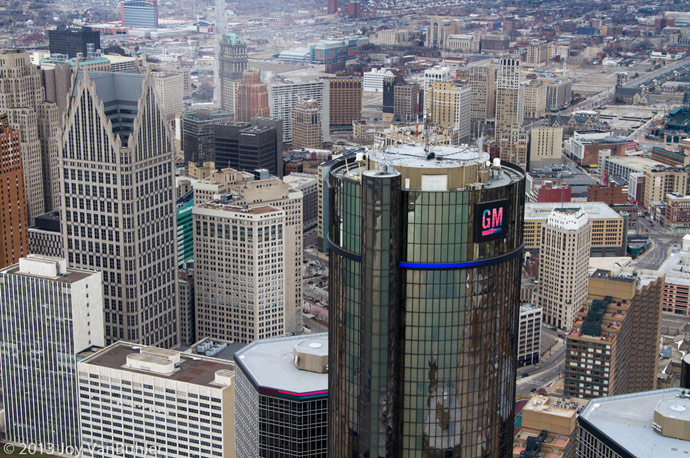18 Facts Behind Detroit’s $18 Billion Dollar Debt

Image via Flickr/ Joy VanBuhler
Sure, everyone knows that Detroit has recently become the largest city in the nation to file for bankruptcy—but there’s more to the story. With an astounding $18 million of debt on its shoulders, it’s no surprise that the city is crumbling beneath its once well-off industrial reputation in America.
Emergency manager Kevin Orr said that it would take more than 50 years to repay its debt. “Does anybody think it’s OK to have 40-year-old trees growing through the roofs of dilapidated houses?” he asked during a news conference on Friday. “Now is our opportunity to stop 60 years of decline,” added governor Rick Snyder.
The following facts show what’s happening in Detroit beyond the number, and how its citizens are affected.
1.) The Detroit population is rapidly declining. “If you look back 30 years ago, there were about 2 million residents of Motown,” said Steve Moore of the Wall Street Journal. “Today that number is about 600,000. So that means that 2 out of every 3 residents of Detroit have left that city in the last 25-30 years.”
2) There are approximately 78,000 abandoned structures, with no money to demolish them. Michigan Central Station is one such structure, and it’s currently the world’s largest abandoned train station. The Packard Plant is also often shown as a symbol of the city’s demise; it was one of the first to be constructed out of reinforced concrete.
3.) Of the 317 parks in Detroit, 210 of them have been closed since 2008. Private donations have delayed the closure of another 50 this year.
4.) Only 8.7 percent of crimes in Detroit are solved, compared to the statewide average of 30.5 percent.
5.) The city receives roughly 700,000 police calls a year, but has decreased police staff by 40 percent over the last decade.
6.) Forty percent of Detroit’s 88,000 streetlights weren’t working in the first quarter of the year. Mayor Dave Bing planned to borrow $160 million to upgrade and reduce the number of streetlights to 46,000. “It touches kids going to school in the dark,” said Cheyfitz, chief executive of Story Worldwide Ltd. “It touches midnight Mass at a church. It touches businesses that want to stay open past 9 p.m.”
7.) Of the 36 ambulances available in the first quarter of the year, only one-third of them were in service. Some ambulances have more than 250,000 miles on them. “The citizens of Detroit need and deserve a clear road out of the cycle of ever-decreasing services,” Gov. Rick Snyder wrote.
8.) They’re actually not bankrupt just yet. Before the bankruptcy can take effect, there is a 30- to 90-day waiting period in which the federal court must determine whether Detroit is eligible for Chapter 9 protection, and what benefits they are able to reap as a result.
9.) Detroit firefighters were ordered not to use the hydraulic ladders on trucks unless there was an “immediate threat to life” because they hadn’t been inspected in years. “What this means is, it greatly complicates our work, and it really makes it difficult for any fire that’s over a couple stories high,” said Dan McNamara, president of the Detroit firefighters union. “It minimizes our ability to put the fire out and also minimizes us to be safe as we’re doing ventilation and rescue operations.”
10.) Governor Rick Snyder says that they cannot currently meet the needs of citizens or creditors. Citizens wait an average of 58 minutes for police to respond to calls, compared to the national average of 11 minutes.
11.) In 1960, the city of Detroit actually had the highest per-capita income in the nation.
12.) A chart comparing manufacturing jobs from 1950 to 2011 shows some dramatic differences: In 1950, there were about 296,000 manufacturing jobs in Detroit and now there are less than 27,000.
13.) Prices of houses in Detroit are extremely low. “Detroit’s housing market reflects those long-term challenges: home prices are far below the national average, and vacancies are much more widespread,” Jed Kolko, chief economist of Trulia told HousingWire. Zillow shows a house on foreclosure for just $1. You can purchase fixer-upper homes in the hundreds-range.
14.) A report released by the Detroit Regional Workforce Fund announced that 47 percent of Detroit’s residents are “functionally illiterate.” This means they’d have trouble filling out job applications, seeking employment, etc. The report reads that the illiteracy is “referring to the inability of an individual to use reading, speaking, writing, and computational skills in everyday life situations.”
15.) According to CNN, the major thing keeping Detroit afloat is the tax revenue from its three casinos. “With 4 of the top 10 most dangerous neighborhoods in the nation, the city needs access to [the casino] money immediately to ensure public safety and keep its police on the streets and its firefighters responding to fires,” said the filing via CNN Money. Detroit is bringing in about 11 million dollars a month in tax revenue from the casinos.
16.) Less than half of Detroit’s population over the age of 16 are working.
17.) A report from Data Driven Detroit shows that 60 percent of Detroit children live in poverty, a 64.7 increase from 1999.
18.) Crime in Detroit is so bad, the Detroit Police Officer Association passed out a flyer prior to a rally that read, “Enter Detroit at your own risk.”









































